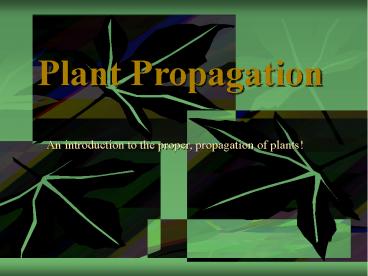Plant Propagation PowerPoint PPT Presentation
Title: Plant Propagation
1
Plant Propagation
An introduction to the proper, propagation of
plants!
2
What Is Asexual Reproduction?
- Asexual reproduction in plants involves the
reproduction of new plants using only the
vegetative parts of the parent plant - Also called Plant Propagation
Courtesy of Interstate Publishers
3
Why Should We Propagate?
- What if the plant is difficult to germinate or
doesnt create a viable seed? - Think about an orchid!
- What if the plant that you want more of is
perfect? You want it to be true to seed.
4
- This form of reproduction produces plants that
are identical to the parent plant
Courtesy of Interstate Publishers
5
- Asexual propagation may be faster than
propagation by seed - Germination and growth of seedlings is often slow
compared to propagation by cuttings - It may also be more economical to produce plants
asexually and in many cases it is easier
So lets learn more about propagation!!!!!
Courtesy of Interstate Publishers
6
Propagation, Interrogation
- Leaf stem cutting
- Division, Separation, and Layering
- Grafting and Budding
- Tissue Culture
7
All of these put together are great ways to
propagate just about any plant!!!!
8
Review of Plant Parts
bud
stipule
stem
midrib
node
axil
internode
blade
petiole
node
9
Leaf and Leaf-Bud Cuttings
- A leaf cutting is a piece of a leaf blade, or a
leaf blade with a petiole attached
A leaf-bud cutting consists of a leaf blade, the
petiole, and a short piece of stem with an
attached bud
10
Leaf Cuttings
- Healthy leaves that have just reached maturity
should be used for leaf cuttings - Some plants may be propagated using only the leaf
blade or a section of the leaf - The leaf is cut from the parent plant and the cut
edge placed on top of the rooting medium or
inserted into the medium - New plants develop along the edge of the leaf.
11
Leaf Cuttings Continued
- Some plants require that both the leaf blade and
petiole be removed from the parent plant - These cuttings should be placed deep enough in
the medium to keep the cutting upright - Moisture is very important for the growth of the
cutting - The cuttings cannot absorb water quickly so they
must be kept moist - However, too much water will cause the cuttings
of most plants to rot
12
Processing the Cutting
- What you should do with the cutting before
planting to ensure less water loss? - Process it immediately
- If not possible put the cut into water and bag it
up. Put it into direct sun. - Remove some of the leaves. About 1/2 to 2/3 of
the leaves. If large leaves are left, cut them
in half. - Place in the rooting medium, put pot in a bag
(keep the bag off of cutting), and put the
processed cutting in the greenhouse. Keep it out
of direct light.
13
Rooting Medium and Root Formation
- Rooting Medium- The substance that allows maximum
root growth. Usually consisting of different
parts water absorbers and aerators. - A good rooting medium should consist of 50
vermiculite and 50 perlite. This will hold
sufficient air and water for maximum root growth. - To encourage root formation, apply a rooting
hormone to the edge of the cutting. - Keep your cuttings at temperatures between 65 and
75 degrees Fahrenheit.
14
Now lets get goin into the greenhouse and
practice some cuttings in our groups!!!!!

